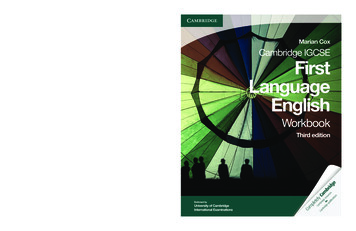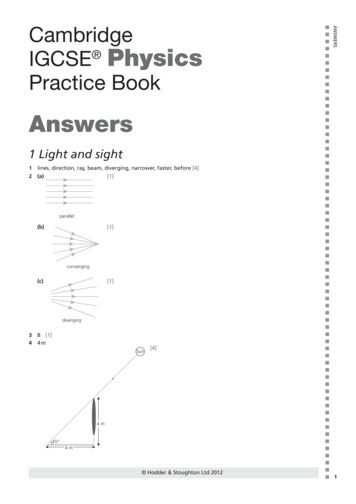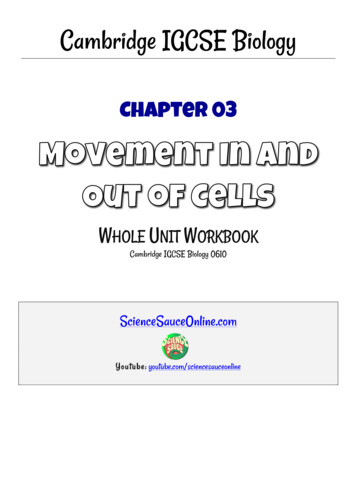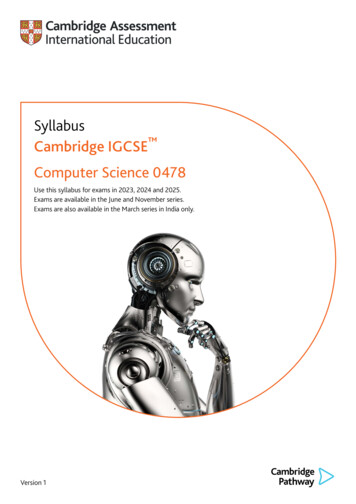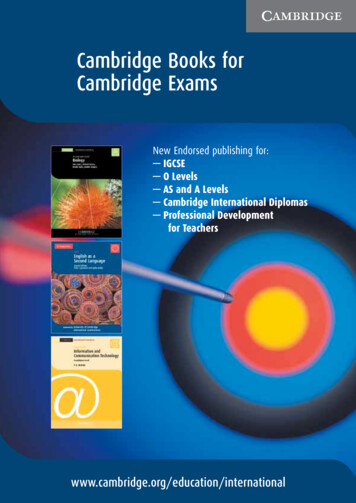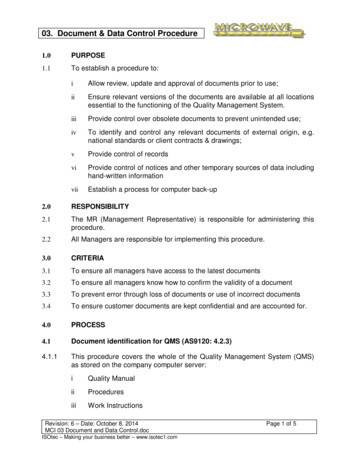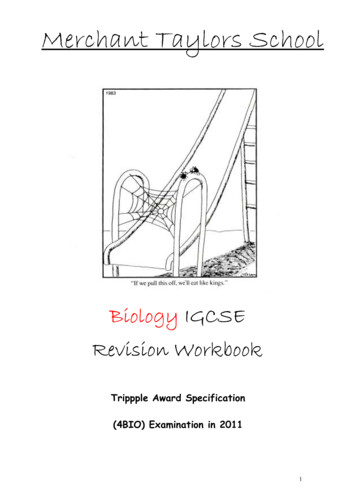
Transcription
Edexcel IGCSE Revision notesWritten by Tim FiltnessMerchant Taylors SchoolBiology IGCSERevision WorkbookTrippple Award Specification(4BIO) Examination in 20111
Edexcel IGCSE Revision notesWritten by Tim FiltnessIGCSE Revision NotesTrippple Award SpecificationKey words are underlined in red. Practical work isprinted in italics.Section 1: The nature and variety of livingorganismsCharacteristics of living organisms include;M ovementR espitationS ensitivityG rowthR eproductionE xcretionN utritionIn addition, all living organisms contain nucleic acids (DNA) andhave the ability to control their internal conditions. Finally, allliving organisms can die.Living organisms are classified into 5 groups, each of which hascertain characteristics you need to learnPlants:Plants1. Multicellular organisms2. Cells contain chloroplasts and are able to carryphotosynthesis3. Cells have cellulose cell wallsout2
Edexcel IGCSE Revision notesWritten by Tim Filtness4. They store carbohydrates as starch or sucrose.Examples include flowering plants, such as a cereal (e.g. maize) anda herbaceous legume (e.g. peas or beans).Animals:Animals1. Multicellular organisms2. Cells do not contain chloroplasts and are not able to carry outphotosynthesis3. Cells have no cell walls4. They have a nervous system5. They often store carbohydrate as glycogenExamples include mammals (e.g. humans) and insects (e.g. housefly).Fungi:Fungi1. They are saprophytic and feed by excreting digestiveenzymes onto food and absorbing the digested products2. Cells do not contain chloroplasts and are not able to carry outphotosynthesis3. Cells are joined together to form threads, called hyphae.Hyphae contain many nuclei, because they are made frommany cells.4. Cell walls are made from chitin (a protein)5. They store carbohydrates as glycogen.Examples include Mucor and Yeast (which is single celled).3
Edexcel IGCSE Revision notesWritten by Tim FiltnessBacteria:Bacteria1. Made from single cells2. Cells do not contain a nucleus, but have a small piece ofcircular DNA instead (a bacterial chromosome).3. Some bacteria can carry out rudimentary photosynthesis, butmost are saprophytes4. They have the structure below (learn it, it comes up!)Examples include Lactobacillius bulgaricus (a rod-shaped bacteriumused in the production of yoghurt from milk) and Pneumococcus (aspherical bacterium that causes Pneumonia)Protoctisis:ProtoctisisBasically, everything that doesn’t fit into the other kingdoms! Mostare single celled organisms which can either;1. Have animal-like characteristics (e.g. Amoeba)2. Have plant-like characteristics (e.g. Chlorella)However, some protoctisis are multicellular (e.g. seaweeds, yesthey’re NOT plants!)Viruses:Viruses1.2.3.4.Much smaller than bacteria. They are not made from cellsTotally parasitic and reproduce inside host cells.They infect every type of living cellThey have the structure below (learn it, it comes up!)4
Edexcel IGCSE Revision notesWritten by Tim FiltnessThe Envelope is used to gain entry into host cells.The Capsid is a protein coat and is used to protect the geneticinformation and give the virus structureThe DNA or RNA (a different type of nucleic acid) contain thecode for building new viruses.Examples include the Tobacco Mosaic Virus and the Influenza virus(which causes ‘flu).Section 2: Structures and FunctionsFunctions inLiving Organismsa) Levels of organizationOrganisms are made from organizations of smaller structures. Youneed to know the following hierarchy of structures.Organelles – intracellular structures that carry out specificfunctions within a cellCells – the basic structural and functional unit from which allbiological organisms are made5
Edexcel IGCSE Revision notesWritten by Tim FiltnessTissues – a group of specialized cells, which are adapted to carryout a specific function.Organs – a collection of two or more tissues, which carries out aspecific function or functionsOrgan Systems – a group of two or more organsb) Cell structureYou need to know the differences between plant and animal cells,the functions of the organelles and be able to recognize them in amicroscope picture or drawing.6
Edexcel IGCSE Revision notesWritten by Tim FiltnessDifferences between plant and animal cells:OrganelleChloroplastAnimal CellXPlant Cell Cell WallX Sap VacuoleX ChlorophyllXFound in chloroplastSizeRoughly 50чm longRoughly 150чm longShapeNo fixed shapeRectangularN.B. The cells are measured in чm (micrometers). One micrometer is1/1000th of a millimetre.Functions of the Organelles:Cytoplasm – site of chemical reactions in the cellCell Membrane – controls what enters / leaves the cell (selectivelypermeable)Nucleus – contains nucleic acids, which code for the synthesis ofspecific proteins. These proteins control all activity in the cellMitochondrion – site of respirationChloroplast – site of photosynthesisCell Wall – made from cellulose. Strengthens the cell and allows itto be turgidSap Vacuole – contains the cell sap. Acts as a store of water, or ofsugars or, in some cases, of waste products the cell needs toexcrete.c) Biological moleculesFood Tests:Lipids are tested for using the Emulsion testProteins are tested for using the Biuret testStarch is tested for using Iodine solutionGlucose is tested for using Benedict’s test7
Edexcel IGCSE Revision notesWritten by Tim FiltnessThe Food Groups:Food GroupLipids (fats & oils)CarbohydratesProteinsFibreWaterFunctionUsed as a long-term energy store (much easier tostore than carbohydrates). Also have a role inprotection and insulationMade from single sugars or chains of sugars. They areused in respiration to provide energy.Broken down into amino acids, which our body absorbsand assembles into new proteins. The proteins are usedfor growth and repair.Regulates bowel movement. Sloughs off old lining ofintestine.Essential as a solvent for chemical reactions (e.g.cytoplasm), heat loss (e.g. transpiration), transport(e.g. blood) etcEssential for the normal function of some enzymes andVitamins and Minerals proteins e.g. Fe2 is an essential part of Haemoglobinand Mg2 is part of ChlorophyllComponents of the main Food Groups:The main food groups are carbohydrates, lipids and proteins. Allthree groups are made from smaller molecules.Carbohydrates are large molecules made from one or more sugars(e.g. both Starch and Glycogen are both polymers of Glucose)Proteins are polymers of Amino AcidsLipids are made from one glycerol molecule and three fatty acidmolecules joined together.8
Edexcel IGCSE Revision notesWritten by Tim FiltnessEnzymes:-Are proteinsAre biological catalysts (speed up chemical reactions)Are specific to one particular SubstrateAre affected by temperature and pHAre not used up in the reaction they catalyze1. Initially, raising the temperatureincreases the rate of reaction.1. Initially,increasingthepHincreases the rate of reaction.2. However, after the optimumtemperature is reached theenzyme begins to change shapeand the active site stops beingable to bind to the substrate.2. However, after the optimum pH isreached the enzyme begins tochange shape and the active sitestops being able to bind to thesubstrate.3. The enzyme becomes denaturedand stop working (the rate ofreaction is zero at this point).3. The enzyme becomes denaturedand stop working (the rate ofreaction is zero at this point).9
Edexcel IGCSE Revision notesWritten by Tim FiltnessYou need to be able to recall an experiment you have done thatexplores the effect of temperature on enzymes. An example is theenzyme Catalase, which breaks Hydrogen peroxide into Water andOxygen;2H2O2 O2 2H2OCatalase is found in potatos. Therefore, putting potato chips intoperoxide will produce O2. The rate of reaction is, therefore,proportional to the volume of O2 given off. Changing thetemperature will alter the volume (i.e. initially increase it, reach anoptimum, then decrease quickly as the Catalase becomesdenatured).d) Movement of substances into and out of cellsDiffusion – the movement of molecules from high concentration tolow concentration, down a concentration gradient.Osmosis – the movement of water molecules from highconcentration to low concentration through a partially permeablemembraneActive Transport – the movement of molecules from lowconcentration to high concentration against the concentrationgradient. Energy is required for movement to occur.Diffusion and osmosis occur because molecules have kinetic energy.The molecules constantly bounce off each other all the time,gradually spreading out. Eventually there will be an even mixture ofmolecules, which is called an equilibrium. Diffusion can be affectedby;- temperature (increases Kinetic energy)- stirring (increases Kinetic energy)- surface area for diffusion10
Edexcel IGCSE Revision notesWritten by Tim Filtness- thickness / distance molecules have to diffuse- the size of the concentration gradient- the surface area to volume ratioPlant cells are normally turgid (swollen full of water). This isimportant because it provides strength to plants. Plant cells have acell wall to stop them bursting when turgid. When plant cells startto lose water they become flaccid. Flaccid plants lose theirstrength and start to wilt. Eventually, flaccid cells becomeplasmolysed as the cell membrane begins to peel away from the cellwall. This kills the cell.You need to give examples of diffusion and osmosis living and nonliving situations. Good examples of diffusion are inkchromatography, or the diffusion of KMnO4 crystals (purple) intowater. Diffusion of gases in the lung or leaf are also good examples.Osmosis can be shown artificially using visking tubing, or potatochips in salt solutions of different concentrations.e) NutritionNutrition in Flowering Plants:Plants are photoautrophic (i.e. they generate their own “food” usingenergy from the Sun.) They do this through photosynthesis.Carbon Dioxide6CO2 Water6H2O Oxygen6O2 GlucoseC6H12O6Through photosynthesis light energy is converted into chemicalenergy in the bonds in glucose. Plants use glucose for the following;-RespirationStored as StarchTurned into Cellulose (cellulose is a polymer of glucose)Used to make fats and oils11
Edexcel IGCSE Revision notesWritten by Tim FiltnessAt any point the rate of photosynthesis can be increased by addingmore CO2, more water, more light or heating towards optimumtemperature (photosynthesis is catalyzed by enzymes). However, ata certain point the addition of more e.g. light will not increase therate of photosynthesis any further. This is because a second factoris limiting the rate of photosynthesis. Adding more of the ratelimiting factor will increase the rate further until another factorbecomes limiting.Rateofp/sLight is the rate-limiting factorA second factor is limiting (e.g. CO2)Light intensityYou need to know the parts of the leaf and their adaptations.12
Edexcel IGCSE Revision notesWritten by Tim FiltnessLeaf StructureCuticleAdaptation for photosynthesisStops the leaf from losing water (remember,water is used in photosynthesis)EpidermisTransparent protective layer. Protects the leafwithout inhibiting photosynthesis.Palisade cellsAre packed full of chloroplasts. Are long andthin so light has to pass through as manychloroplasts as possible.Air SpacesIncrease the surface area inside the leaf tomaximise gas exchange across the surface ofthe Spongy Mesophyll cellsStomaAllow exchange of CO2 and O2Guard CellsAllow the stoma to open and close to stop theleaf losing too much waterVein (containing Xylem) Brings a steady supply of water to the leaf.In addition to water and CO2 plants also need specific minerals;NitrateMagnesiumPotassiumPhosphate– used to make amino acids for use in plant proteins– forms part of the chlorophyll molecule- essential for cell membranes- essential part of DNA and cell membranesYou need to know an experiment that shows how the rate of p/s isaffected by rate-limiting factors. The best example is using pondweed (Elodea) which produces bubbles of O2 as it photosynthesizes.The rate of bubble production is approximately proportional to therate of photosynthesis. Therefore, when you add light or give itmore CO2, the rate of bubble production increases.You also need to know an experiment that proves that light and CO2are essential for the production of starch. A good example is theGeranium plant. It’s leaves normally turn blue-black in the presenceof iodine solution showing starch is present (you have to boil it inethanol first to remove the chlorophyll to show the colour).However, if one leaf is put in aluminum foil and another is kept withlime water both do not turn blue-black, implying both CO2 and lightare essential for starch production and, therefore, essential forp/s.13
Edexcel IGCSE Revision notesWritten by Tim FiltnessNutrition in Humans:Humans need to eat a balanced diet. This really means some ofevery food group, but not too much or too little of a particular one.The two groups that provide energy (through respiration) are lipidsand carbohydrates. Per mass lipids have about 10x more energy inthem than carbohydrates. The energy in food is measured inCalories (equivalent to 4.2 kJ). In order to keep our bodiesfunctioning (i.e. heart beating, basic respiratory requirement)- Males need to consume 2500 Calories a day- Females need to consume 2000 Calories a dayHowever, this will change if;-You exerciseYou are growingYou are illYou are pregnantYou are oldYou need to know an experiment that can show how much energythere is in food. The easiest way of doing this is to burn a sample offood and use it to heat a fixed volume of water. If you record thechange in temperature of the water you can use the equation belowto find out the energy the food gave to the water;Energy change in temp. x volume of water x 4.2J/g/ CA potential problem is that not all the food will burn. To controlthis, you measure the start and end mass of the food and calculatethe mass that actually burned. To standardize this, you can divideyour calculated energy value by the change in mass to give you thechange in mass per gram of food (which will allow you to comparevalues fairly between different food samples)14
Edexcel IGCSE Revision notesWritten by Tim FiltnessYou need to know the specific sources and functions of thefollowing minerals and vitaminsVitamin / MineralVitamin AVitamin CVitamin DCalciumIronFunctionPresent in fish, cheese and eggs. It forms anessential part of the pigment in rods and conesthat detects light. Lack of Vitamin A can lead toblindness.Present in citrus fruit. It forms an essentialpart of collagen protein, which makes up skin,hair, gums and bones. Lack of Vitamin C causesscurvy.Present in fish, but made naturally by our bodywhen sunlight shines on the skin. It is essentialfor regulating the growth of bones. Lack ofVitamin D can cause rickets.Present in milk, cheese & dairy foods. It isessential for bone growth and muscles. Lack ofcalcium can lead to osteoporosis.Present in red meat and some vegetables (e.g.spinach). Is part of haemoglobin. Lack of ironcauses anaemia.Digestive System:15
Edexcel IGCSE Revision notesWritten by Tim FiltnessThe purpose of digestion is to break food into molecules that aresmall enough to be absorbed into the bloodstream. There are twotypes of digestion;Mechanical Digestion: digestion by physically breaking food intosmaller pieces (i.e. not using enzymes). Carried out by;- mouth and teeth chewing food- stomach churning foodChemical Digestion:digestion using enzymesYou need to know the following enzymes;Where it ismadeWhere it worksEnzymeSubstrateProductsSalivary GlandsMouthAmylaseStarchMaltoseStomach cellsStomachProteaseProteinAmino AcidsLiverSmall IntestineBile SaltsFatFat seProteaseMaltoseProteinMaltoseAmino AcidsGlycerol & FattyacidsGlucoseAmino AcidsPancreasSmall IntestineSmall IntestineSmall IntestineBile salts are not technically enzymes. They are made in the liverand stored in the gall bladder. They help by emulsifying lipid (i.e.turning large fat droplets into lots of tiny droplets). This increasesthe surface area, which helps lipase actually break the lipid down.Bile also has a second job. Bile is alkali, which is important forneutralizing stomach acid as soon as it leaves the stomach.Stomach acid is important because it kills any bacteria that enterthe stomach. Stomach acid does not play a significant role indigestion.16
Edexcel IGCSE Revision notesWritten by Tim FiltnessKey Ideas:Ingestion:taking food into the digestive systemDigestion:breaking food down into molecules small enough tobe absorbed into the bloodstream.Absorption:taking molecules into the bloodstream. Thishappens almost entirely in the small intestine(ileum)Assimilation:using food molecules to build new molecules in ourbodies. I.e. the food molecule physically becomespart of our body.Egestion:Removing unwanted food from the digestivesystem (having a poo!). This is not excretion,because the unwanted food has never, technically,been inside the body.Peristalsis:the contraction of muscle in the intestine wallbehind a bolus of food (ball of food). This pushesthe bolus through the intestine.Small intestine adaptations:AdaptationThin wallRich blood supplyIntestine lengthSurface AreaExplanationThe intestine wall in thin, which speeds the rateof diffusion of molecules into the bloodThis helps carry absorbed molecules away fromthe intestine quickly. This means there is alwaysa low concentration of food molecules in theblood, which maintains a high concentrationgradientRoughly 7m long, which increases the surfaceareaVilli and microvilli increase the surface area ofthe small intestine by 1000x17
Edexcel IGCSE Revision notesWritten by Tim Filtnessf) RespirationRespiration is the process that releases energy into every living cellof every organism. The energy is essential for keeping the cell aliveas it powers processes like protein synthesis, growth, repair,division etc.Oxygen6O2 GlucoseC6H12O6 Carbon Dioxide6CO2 Water6H2OSome cells have the ability to respire without using oxygen. This iscalled anaerobic respiration. Only liver and muscle cells can do thisin humans. Anaerobic respiration allows the cell to carry on workingdespite there being a shortage of oxygen (this is very useful inmuscle cells – particularly if you are running for your life!)GlucoseC6H12O6 Lactic Acid2CH3CHOHCOOH(interest only – don’t learn)Anaerobic respiration produces Lactic Acid, which is poisonous.Lactic acid builds up inside muscle cells and quickly leads to musclefatigue and cramp. Eventually the muscle cell will stop working.During recovery the lactic acid is transported to the liver via thebloodstream. The liver breaks the lactic acid into CO2 and water.Oxygen is required for this, which is called the Oxygen Debt.Yeast also respire anaerobically, except they do not produce lacticacid like humans. Instead they make ethanol. This type of anaerobicrespiration is also called alcoholic fermentation. It is used in thebaking and brewing processes.GlucoseC6H12O6 Ethanol2CH3CH2OH Carbon Dioxide2CO2(interest only)You need to know an experiment that shows that living organismsproduce CO2 through respiration. The best example is to suspendsome maggots or seeds near the top of a test tube sealed with abung (suspend the maggots / seeds in a wire mesh). A small amount18
Edexcel IGCSE Revision notesWritten by Tim Filtnessof lime water in the bottom of the test tube will turn milky overtime, indicating that CO2 has been produced.g) Gas exchangeGas Exchange in Flowering Plants:Remind yourself of the structure of the leaf (Section 2e –Nutrition in Flowering Plants).Remember that CO2 and O2 diffuse in and out of leaves throughstomata. Remember that CO2 is used in photosynthesis andproduced by respiration, whereas O2 is used in respiration andproduced in photosynthesis!Both processes run all the time. So the net amount of glucose theplant produces (i.e. the amount it gets to use for growth etc) isgoverned by the formula;Net Glucose Total production–Amount used in respirationThe amount the plant uses in respiration in nearly constant.However, the total production is not. It is dependent on the ratelimiting factors (i.e. light intensity, CO2 level, water availability,temperature etc). In winter the net glucose production is virtuallyzero, whereas in summer the net glucose production is large.Therefore, plants grow a lot during the summer and not muchduring winter!19
Edexcel IGCSE Revision notesLeaf StructureAir SpacesStomaMesophyll cellsLeaf shapeStomata distributionWritten by Tim FiltnessAdaptation for gas exchangeIncrease the surface area inside the leaf tomaximise gas exchange across the surface ofthe Spongy Mesophyll cellsAllow exchange of CO2 and O2Have a large surface area and moist surfaces,which speeds gas exchangeLeaves are thin, which increases diffusionspeeds and leaves also have a very large surfacearea, which also increases diffusion speed.Stomata are spread out over leaves, which meanswaste gases produced by the leaf can diffuseaway quickly, this stops the build-up of excretedproducts, which would slow gas exhangeYou need to know an experiment which will show the effect of lightintensity on the rate of gas exchange. The best example is to sealtwo leaves (still attached to the plant) in separate plastic bags withsome bicarbonate indicator solution. One of the bags is black andthe other is translucent. The leaf in the black bag produces CO2 viarespiration and the colour of the bicarbonate indicator changesquickly to yellow. The leaf in the translucent bag produces O2 viaphotosynthesis and the bicarbonate indicator solution changes tored slowly.Bicarbonate Indicator colours:Red in the presence of O2Yellow in the presence of CO220
Edexcel IGCSE Revision notesWritten by Tim FiltnessGas Exchange in Humans:Larynx ercostal MuscleThoracic Cavitycontained withinpleural membranesDiaphragmHow breathing works1.2.3.4.5.Breathing in (inhaling)Intercostal muscles contract,pulling the ribcage forwardsand outDiaphragm contracts movingdownThe volume of the ThoracicCavity increasesThe pressure in the ThoracicCavity decreasesAir is drawn into the lungs toequalize the pressure1.2.3.4.5.Breathing out (exhaling)Intercostal muscles relax, theribcage moves inwards anddownDiaphragm relaxes moving upThe volume of the ThoracicCavity decreasesThe pressure in the ThoracicCavity increasesAir leaves the lungs to equalizethe pressureInhaling is an active process, i.e. it The entire process is passive, i.e. norequiresenergyformuscle energy is required as there is nocontractionmuscle contraction.21
Edexcel IGCSE Revision notesWritten by Tim FiltnessAlveoli and their adaptations:Adaptations for gas exchange:- Alveolus is one cell thick- Capillary wall is one cell thick- Many alveoli produce a hugesurface area- Alveoli wall is moist- Breathing maintains a highconcentration gradient for O2and CO2- Blood movement maintains ahigh concentration gradient forO2 and CO2Smoking:Cigarette smoke contains tar, nicotine, carcinogens, CO and poisonsChemicalTarNicotineCarcinogensCarbon MonoxidePoisonsEffectBlocks up alveoli, making gas exchange more difficult.Also clogs up cilia (little hairs lining the lungs, whosejob is to “wave” and remove mucus and trappedbacteria out of the lungs).Speeds heart rate and damages arteries, causingfurring of artery walls (atherosclerosis). This leadsto heart disease and vascular diseases. It is alsoaddictive.Damages the DNA of alveoli cells. This can lead tothem reproducing faster than normal, which will causea tumour to form. The tumour is the start of cancer.Attaches permanently to haemoglobin, reducing theability of the blood to carry O2The list is endless. There are over 5000 poisonouschemicals in cigarette smoke (e.g. benzene, arsenic,lead, cyanide etc)22
Edexcel IGCSE Revision notesWritten by Tim FiltnessYou need to know an experiment that will show the effect ofexercise on humans. The easiest experiment is to take your ownheart rate, breathing rate and skin temperature at rest. Do someexercise, then take the same measurements again. You’ll findthey’ve all increased. The reason for this is that your rate ofrespiration has increased (to supply the muscles with extra energyfor contraction). In order to get respiration to happen faster, youneed more O2, so the breathing and heart rate increase.Unfortunately, you also release more waste heat energy, so yourbody heats up and you might have to start sweating to cool it downagain.h) TransportAll organisms respire (well, nearly all, but according to your syllabusthey all do). Therefore, all organisms need to exchange gases withtheir environment.Unicellular organisms: exchange gases directly through their cellmembrane. They can do this because their surface area is largecompared to their volume (large SA:Vol ratio). They do not need acirculatory system.Multicellular organisms: cannot exchange gases directly throughtheir skin. Their surface area is very small compared to theirvolume (small SA:Vol ratio); therefore, they need to havespecialized gas exchange organs (e.g. leaf, lung and gill) and acirculatory system.Transport in Flowering plants:Plants have two different networks of tubes inside them;Phloem: transports sucrose and amino acids up and down the stemXylem: transports water and minerals up the stem23
Edexcel IGCSE Revision notesWritten by Tim FiltnessPhloem and Xylem are arranged in separate bundles (vascularbundles) inside the stem. The xylem is on the inside and the phloemis on the outside. This arrangement is different in roots (but youdon’t need to know it)Transport in the phloem is tricky, but fortunately not on yoursyllabus. It is not the same as transport in the xylem, which occursby the process of transpiration.Transpiration is the movement of water up a plant, from theroots, through the stem and finally out of the leaves.In the Roots:Water enters root hair cells by osmosis. The roots are full ofminerals, which artificially lower the concentration of water insidethe root cells, so water is always drawn into them from the soil.This enables transpiration to happen even if the soil is very dry.The roots take the minerals up against the concentration gradientand is, therefore, an example of active transport.Root hair cells increasethe root’s surface area24
Edexcel IGCSE Revision notesWritten by Tim FiltnessIn the Stem:1. Water evaporates out of the top of the xylem2. This generates a low pressure at the top of the xylem (a minivacuum, if you like)3. This sucks water molecules up the xylem4. This is called transpiration pullExtension (not on syllabus, but very interesting )Water molecules are slightly charged (polar). The oxygen atom isslightly negative and the hydrogens are slightly positively charged.This means that water molecules tend to stick to each other.Therefore, when transpiration pull sucks at the water molecules inthe top of the xylem, the entire column of water moves up thexylem, not just the molecules at the top!In the leaf:Water enters the leaf in xylem vessels in veins (basically, anothername for a leaf vascular bundle). The water moves by osmosis intoleaf mesophyll cells, where it evaporates into the air spaces andfinally diffuses out of the stomata into the air.Factors affecting the rate of stranspiration)Light intensity(increasestranspiration)Effect on transpiration rateIncreasing temperature increases the kinetic energyof molecules. This makes diffusion, osmosis andevaporation happen fasterWhen the air is humid then there is more watervapour in it. Humid air is less able to accept morewater molecules by evaporation.Wind blows water vapour away from the stoma,keeping the concentration gradient high.Light causes stoma to open. Wider stoma can allowfaster diffusion of water vapour out of the leaf.25
Edexcel IGCSE Revision notesWritten by Tim FiltnessYou need to know an experiment that can show the effect of theabove factors on the rate of transpiration. The best experiment isa potometer, which measures how quickly a little bubble of airmoves up a glass tube attached to the bottom of the stem. Adding afan, changing the humidity, increasing the temperature etc will allchange the speed the bubble moves up the tube.Why do plants need water (why do they bother to transpire)?- Used in photosynthesis ( 10%)- A solvent for transporting other things (e.g. minerals) ( 10%)- Used in chemical reactions ( 5%)- A site of chemical reactions ( 5%)- Cooling the plant ( 70%)26
Edexcel IGCSE Revision notesWritten by Tim FiltnessTransport in Humans:Blood consists of 4 main parts;Plasma – mostly water used for transporting things around thebody (i.e. CO2 glucose, amino acids, other products of digestion,urea, hormones and heat energy.Red Blood Cells – adapted to carry O2 around the body. O2attaches to haemoglobin protein, which the RBCs are filled with.Other adaptations of RBCs include;-Smooth edgesBiconcave shape (increases surface area and allows folding)Made in huge quantitiesNo nucleus (so more room for haemoglobin)Platelets – help clot the blood. This stops blood loss and alsoprevents microorganisms entering the body.White Blood Cells – are part of the immune system. There aretwo main types; macrophages and lymphocytes.Macrophages (sometimes called Phagoctyes)Travel in the blood. They detectforeign bodies (i.e. foreign cells,toxins, cells infected with virus andcancerous cells) and engulf anddestroy them.LymphoctyesStay in the lymph system (you don’t needto know what this is). They make antibodyproteins in large numbers. Antibodyproteins travel in the blood and stickto foreign objects. This helpsbecause;1. foreign objects are stuck toeach other, stopping themspreadingEngulfing and destroying is calledphagoctyosi
Edexcel IGCSE Revision notes Written by Tim Filtness 5 The Envelope is used to gain entry into host cells. The Capsid is a protein coat and is used to protect the genetic information and give the virus structure The DN
